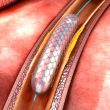The association between glycemic control after coronary angioplasty and outcomes of the latter is controversial in many studies. We have come to think that the risk lies in suffering from diabetes, as if it was an unmodifiable factor. We have also come to believe that glycemic control can impact microvascular complications while it cannot do<a href="https://solaci.org/en/2017/07/12/glycemic-control-and-risk-of-repeat-revascularization/" title="Read more" >...</a>
Successful angioplasty in elderly patients with chronic total occlusion reduces mortality
Courtesy of Dr. Carlos Fava. Nowadays, the number of coronary angioplasties carried out on patients with chronic total occlusion (CTO) is increasing due to many studies showing that it improves ventricular function, reduces symptoms, and improves survival. However, most of these works do not include patients of over 75 years old due to their frailty and<a href="https://solaci.org/en/2017/06/19/successful-angioplasty-in-elderly-patients-with-chronic-total-occlusion-reduces-mortality/" title="Read more" >...</a>
AIDA: bioresorbable scaffold thrombosis still a concern in studies
Courtesy of the SBHCI. This study presented at PCR and simultaneously published by NEJM still challenges the safety of bioresorbable scaffolds. This was a multicenter noninferiority work carried out in the Netherlands, comparing 1:1 everolimus-eluting bioresorbable scaffold ABSORB and permanent-polymer everolimus-eluting stent Xience. The primary endpoint was target-vessel failure (a composite of cardiac<a href="https://solaci.org/en/2017/06/02/aida-bioresorbable-scaffold-thrombosis-still-a-concern-in-studies/" title="Read more" >...</a>
TOPIC: Benefits of Switching Dual Antiplatelet Therapy in Patients with ACS
Newer P2Y12 blockers are the front-line treatment and dual antiplatelet therapy is indicated for 1 year after acute coronary syndrome (ACS). Both prasugrel and ticagrelor offer more ischemic benefit than clopidogrel during the initial phase; however, bleeding complications could increase in the long term. The objective of this study was to assess the safety and efficacy<a href="https://solaci.org/en/2017/05/23/topic-benefits-of-switching-dual-antiplatelet-therapy-in-patients-with-acs/" title="Read more" >...</a>
TAVR in Intermediate-Risk Patients: Is It as Effective as Surgical Aortic Valve Replacement?
Courtesy of Dr. Carlos Fava. Transcatheter aortic valve replacement (TAVR) has proven to be beneficial for extreme- and high-risk patients. It is also increasingly used in intermediate-risk patients, and it has been hinted at for low-risk patients. However, different sectors in the medical community still challenge the existence of real TAVR benefit. This assessment consisted<a href="https://solaci.org/en/2017/05/03/tavr-in-intermediate-risk-patients-is-it-as-effective-as-surgical-aortic-valve-replacement/" title="Read more" >...</a>
Is Impella an option in high-risk angioplasty?
Courtesy of Dr. Carlos Fava. Provitional ventricular assist devices are increasingly used in high-risk angioplasties, particularly those involving unprotected left main coronary artery (LMCA) with defective ventricular functioning. However, so far its true role has not been well-studied. This study analyzed 127 consecutive patients in the USpella registry from 2008 to 2015. These subjects underwent high-risk<a href="https://solaci.org/en/2017/05/03/is-impella-an-option-in-high-risk-angioplasty/" title="Read more" >...</a>
Tricuspid valve repair with the MitraClip technique
Current surgical and medical treatment options for severe tricuspid regurgitation are extremely limited. However, this historically forgotten valve seems to have the option of transcatheter repair, nowadays. This observational study assessed the safety and feasibility of the MitraClip system for patients with severe chronic tricuspid regurgitation. All patients presented severe tricuspid regurgitation and<a href="https://solaci.org/en/2017/04/27/tricuspid-valve-repair-with-the-mitraclip-technique/" title="Read more" >...</a>
Proximal anterior descending artery angioplasty: what are its long-term outcomes?
Courtesy of Dr. Javier Castro. Certain coronary lesions have been historically discouraged for endovascular treatment. Among these can be found left main coronary artery lesions, multivessel disease, and proximal anterior descending artery lesions. As a matter of fact, the latter is actually considered separately as a criterion for choosing the revascularization method. Endovascular treatment of<a href="https://solaci.org/en/2017/04/20/proximal-anterior-descending-artery-angioplasty-what-are-its-long-term-outcomes/" title="Read more" >...</a>
FFR-Guided ACS Revascularization Apparently Superior to Culprit Vessel Treatment
Using fractional flow reserve (FFR) to guide revascularization of all functionally significant lesions in the setting of acute coronary syndrome appears to improve outcomes over treating only the culprit artery, according to the Compare-Acute trial. This study, conducted at 24 centers in Europe and Asia, enrolled 885 patients who were stable following successful primary angioplasty and<a href="https://solaci.org/en/2017/04/11/ffr-guided-acs-revascularization-apparently-superior-to-culprit-vessel-treatment/" title="Read more" >...</a>
Pregnancy and Risk of Spontaneous Coronary Artery Dissection: How to Proceed
Courtesy of Dr. Pablo Baglioni. Between the years 2000 and 2015, the authors of this article searched for reports on spontaneous coronary artery dissection (SCAD) in pregnant or immediate post-partum women aiming at defining the clinical characteristics of this pathology and offering management recommendations. Information on 120 women was analyzed; 116 were between 22<a href="https://solaci.org/en/2017/04/03/pregnancy-and-risk-of-spontaneous-coronary-artery-dissection-how-to-proceed/" title="Read more" >...</a>









